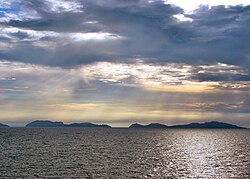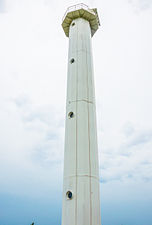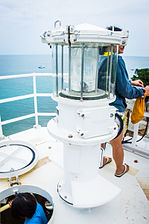geo.wikisort.org - Island
Islas de Gigantes (Spanish: Gigantes Islands lit: Giant Islands) (variously Islas Gigantes, Higantes group, or Gigantes group) is an island chain within the larger Western Visayas archipelago in the Visayan Sea. It is part of the municipality of Carles, Iloilo, Philippines, and the northernmost part of Iloilo province. The Gigantes islands consist of about ten islands; the two largest are Gigantes Norte (North Gigantes) and Gigantes Sur (South Gigantes). According to the 2010 census, it has a population of 12,224.[1] There is also a lighthouse on Gigantes Norte.
 North and South Gigante Islands seen from the Visayan Sea | |
 Islas de Gigantes Location within the Philippines | |
| Geography | |
|---|---|
| Coordinates | 11°35′39″N 123°20′11″E |
| Adjacent to |
|
| Total islands | 10 |
| Major islands |
|
| Administration | |
Philippines | |
| Region | Western Visayas |
| Province | Iloilo |
| Municipality | Carles |
| Barangays |
|
| Demographics | |
| Population | 12,224 (2010) |
Location and geography
The Gigantes islands are located roughly 18 kilometres (11 mi) from Panay Island in the Visayan Sea. Gigantes Norte is 213 metres (699 ft) at its highest point, while Gigantes Sur is 232 metres (761 ft) at its highest point. A narrow 800-metre-wide (0.5 mi) channel separates the two islands.[2] Nearby islands include Balbagon Island, which is 6 kilometres (3.7 mi) west of Gigantes Sur and is part of barangay Lantangan.
In addition to the two main islands, the Gigantes group includes the following minor islets: Bulubadiang, Gigantillo, and Gigantuna are islets southeast of Gigantes Norte, while Antonia, Bantigui, Cabugao, Tanguingui, and Turnina are islands and islets south of Gigantes Sur.[2]
The Gigantes group consists of the following four barangays. On Gigantes Norte is Asluman and Granada and on Gigantes Sur is Lantangan and Gabi.
History
The Gigantes group used to be called Sabuluag, or Salauag, which is the name of a species of tree endemic to the islands. During the Spanish colonial era, the name was changed to Gigantes. Local legend describes coffins found inside Bakwitan Cave that contained gigantic sets of human bones, which constituted the name change.[3] For this reason, locals also believe the island is inhabited by engkantos.
A lighthouse was built on Gigantes Norte some time before 1895. Designated ARLHS PHI-094, the white 38-foot-high (12 m) tower features a keeper's house and a focal point 77 feet (23 m) in the air, which flashes once every ten seconds.[4] Lantangan Elementary School in Gigantes Sur has a student population of 1,144, which is higher than the populations of mainland schools.[5]
Typhoons
Typhoon Fengshen, known in the Philippines as Frank, struck the Gigantes group in June 2008. Fengshen destroyed the original lighthouse on Gigantes Norte, which was one of the original 27 lighthouses built by the Spanish in the Philippines.[6] Japan donated a replacement tower, which is made of iron and solar powered. The brick keeper's house is all that remains of the original structure.
Typhoon Haiyan, known in the Philippines as "Yolanda", passed over the Gigantes group, along with the rest of Panay, on November 8, 2013,[7] damaging houses and boats. Unofficial reports stated more than 90 percent of the houses on Gigantes were destroyed.[8] The typhoon also tore the roof off of Lantangan Elementary School in Gigantes Sur. As of June 2014, the roof of the school had not yet been repaired.[5] Many groups conducted relief missions to the Gigantes group, including the Bureau of Fisheries and Aquatic Resources in Region 6 (BFAR-6), the Department of Social Welfare and Development (DSWD-6), RockEd Philippines-RockEd Iloilo, the ABS-CBN Foundation, Loma Linda University Health (LLUH), and the Adventist Development and Relief Agency (ADRA).[9][10] In June 2014, Save the Children donated more than a thousand bags of school supplies to students on the island.[5] Aside from food and clothing, the fishing community also asked relief organizations to help rebuild their livelihoods.[11]
Points of interest
Points of interest in the Gigantes group include the Cabugao Gamay Island, Antonia Island, Bantigue Sand Bar, and Bakwitan Cave, one of 73 caves throughout the islands.
Tangke

Tangke is a saltwater lagoon located within Gigantes Sur. It is surrounded by cliffs. One local myth surrounding Tangke states that the waters would magically rise every year on June 24 during the feast of Saint John the Baptist.
North Gigantes Island lighthouse
The station was established during 1895 as one of the Spanish lighthouse projects to be built across the Philippines. The current medium-sized lighthouse that is solar-powered, like most of the lighthouses built today, was donated by Japan to replace the one built by the Spanish government due to the destruction brought by Typhoon Frank in 2008. The keeper's house survived but in ruins. The masonry walls were painted white while the roof is made out of corrugated galvanized iron sheet in red paint finish.[4]
Cabugao Gamay
A small island featuring a white sand beach and an observation deck.[12]
Antonia Beach
The private beach which belongs to a resort (Antonia Resort) on the south eastern tip of Gigantes Sur, known for its 1 peso scallops.[13]
- Beside the lighthouse is a single-storey elevated ruin with arched openings on one side
- This is the new solar-powered lighthouse which was once the location of the Spanish-colonial parola
- The pathway that leads to the old quarters
- The signal lamp on lighthouse deck
Transport
via Carles
Boats can be chartered from Bancal Port in Carles.[14] Public ferries leave daily from Bancal Port to either Gigantes Norte or Gigantes Sur. Private boats can also be chartered to reach the islands. It takes approximately an hour from Bancal Port to Gigantes islands.
via Estancia
Daily trips are also available from the port of Estancia, which can be reached via point-to-point bus operated by Ceres from their terminal just outside Iloilo City. The single trip leaves at approximately 1300 hours daily and takes about 1.5-2 hours to complete.
Gallery
- Gigantes Norte Limestone Cliffs
- A white sand beach at Antonia Island
- Cabugao Gamay Island
- Bantigue Sandbar
- Gigantes Norte coast with Gigantes Lighthouse
See also
- List of islands in the Philippines
References
- National Statistics Office. 2010 Census of Population and Housing (PDF). p. 61. Archived from the original (PDF) on November 15, 2012. Retrieved June 7, 2014.
- National Geospatial-Intelligence Agency (2008). Sailing Directions (Enroute) Philippine Islands (PDF) (7th ed.). Bethesda, Maryland: National Geospatial-Intelligence Agency. p. 94. Archived (PDF) from the original on April 2, 2013. Retrieved June 19, 2014.
- "Isla de Gigantes -- Newest Hidden Paradise in the Philippines". CNN iReport. June 19, 2013. Archived from the original on December 25, 2013. Retrieved December 24, 2013.
- Rowlett, Russ. "Lighthouses of the Philippines: Panay and Guimaras". The Lighthouse Directory. University of North Carolina at Chapel Hill.
- Tayona, Alfred John; Villa, Hazel P. (June 21, 2014). "Yolanda-Ravaged School in North Iloilo Still Roofless". Yahoo News. Archived from the original on July 14, 2014. Retrieved July 2, 2014.
- Rowlett, Russ. "Spanish Lighthouses of the Philippines". The Lighthouse Directory. University of North Carolina at Chapel Hill. Retrieved July 1, 2014.
- ""Typhoon 'Yolanda' Destroys Several Towns in Iloilo"". CBCP News. November 12, 2013. Archived from the original on November 11, 2014.
{{cite news}}: CS1 maint: unfit URL (link) - "Holiday Turns Into Helping Mission". ABC News. December 10, 2013. Archived from the original on December 26, 2013. Retrieved December 24, 2013.
- Atienza, Herbert (December 13, 2013). "Loma Linda University Health Disaster Response Team Joins with Adventist Development and Relief Agency to Help in Super Typhoon Haiyan Recovery Efforts in Philippines". PRWeb. Archived from the original on December 21, 2013. Retrieved December 24, 2013.
- "Visayas Newsbits for November 19, 2013". Manila Bulletin. November 18, 2013. Archived from the original on December 26, 2013. Retrieved December 24, 2013.
- Yap, Tara (December 1, 2013). "Fishermen Need Help with Boats". Manila Bulletin. Archived from the original on March 6, 2014. Retrieved February 24, 2014.
- "The Internet Famous Cabugao". unofficialguide.ph. Archived from the original on February 13, 2018. Retrieved June 26, 2017.
- "Island Hopping in Gigantes Sur". unofficialguide.ph. Archived from the original on February 13, 2018. Retrieved June 12, 2017.
- Muzones, Gem. "Islas de Gigantes Iloilo Island Hopping Guide: Best Time to Go, How to Go, Where to Stay, Itinerary". Guide to the Philippines. Archived from the original on May 24, 2022. Retrieved August 10, 2022.
External links
 Media related to Gigantes Islands at Wikimedia Commons
Media related to Gigantes Islands at Wikimedia Commons
На других языках
[de] Gigante-Inseln
Die Gigante-Inseln, teilweise auch Gigantes-Inseln (englisch Gigantes Islands[1]) genannt, sind eine Inselgruppe im Archipel der Visayas in den Philippinen. Die Gruppe aus etwa 14 Inseln liegt in der westlichen Visayas-See, ca. 26 km nordöstlich der Insel Panay. Der kleine Archipel gehört zum Verwaltungsgebiet der Gemeinde Carles und damit zur Provinz Iloilo.- [en] Islas de Gigantes
Другой контент может иметь иную лицензию. Перед использованием материалов сайта WikiSort.org внимательно изучите правила лицензирования конкретных элементов наполнения сайта.
WikiSort.org - проект по пересортировке и дополнению контента Википедии








